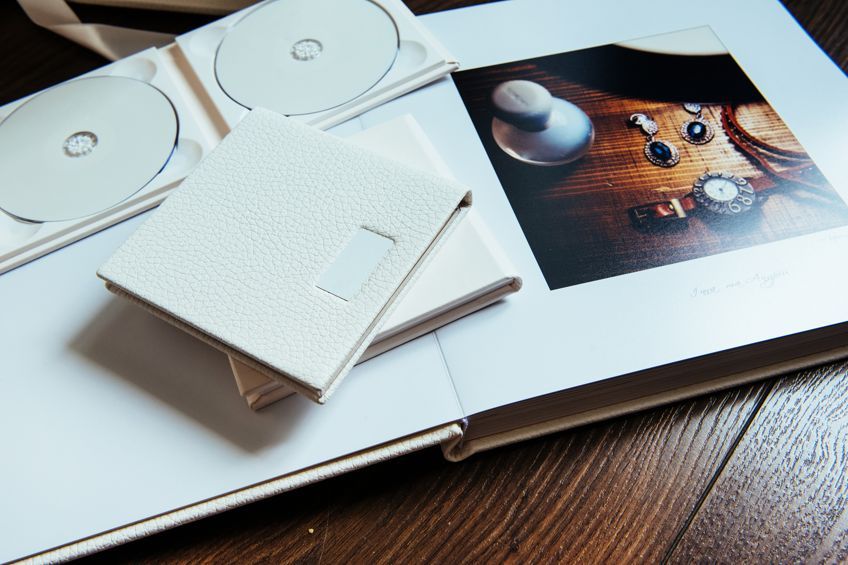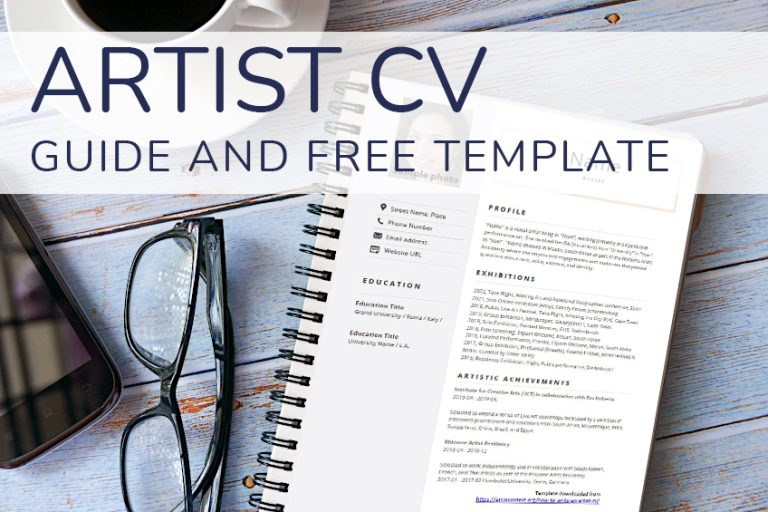How to Make an Art Portfolio – What Is an Art Portfolio Used For?
Researching how to make an art portfolio is one of the first and most important steps of any creative’s art career. You need to be able to show prospective clients and collaborators the work you make. This is where a visual document or an online art portfolio comes in. What is an art portfolio? This is the core question this article will explore and from the insights reached we will provide you with a clear guide on how to make an art portfolio. When going through the steps of creating an art portfolio, we will also discuss the option of creating an online art portfolio and what to put in an art portfolio.
What Is an Art Portfolio?
All artists should have an art portfolio. Nowadays, social media (specially curated platforms like Instagram) can act as an informal online art portfolio. However, if you want to make a serious profession of your art, it is a good idea to invest time and energy in creating a professional art portfolio. An art portfolio is the most important supporting material or document for your art practice.
Above your business card, bio, resume, and elevator pitch, your art portfolio is what will help others visualize your work if they cannot view it in person.

An artist’s website can double up as an online art portfolio, but there are specific considerations you need to keep in mind when making your website your online portfolio. Other online art portfolio options include creating an art portfolio on sites that host it for you. This is a good option if you do not want to design an entire website (more about this in the section on online art portfolios).
Your art portfolio – whether a separate document or an online portfolio hosted on your website – should focus on your art and highlight the artwork while still giving more information about you as the artist. It is an opportunity for you to introduce your art style, artist identity, and business brand to an interested viewer.
You can also think of your portfolio as offering a viewer an experience or journey of your work.
How to Make an Art Portfolio
A few decades ago, museums and galleries held all the power to display art. Only the elite could access it and it was not possible for artists to market themselves on their own. The internet and the everyday use of the computer changed that completely.
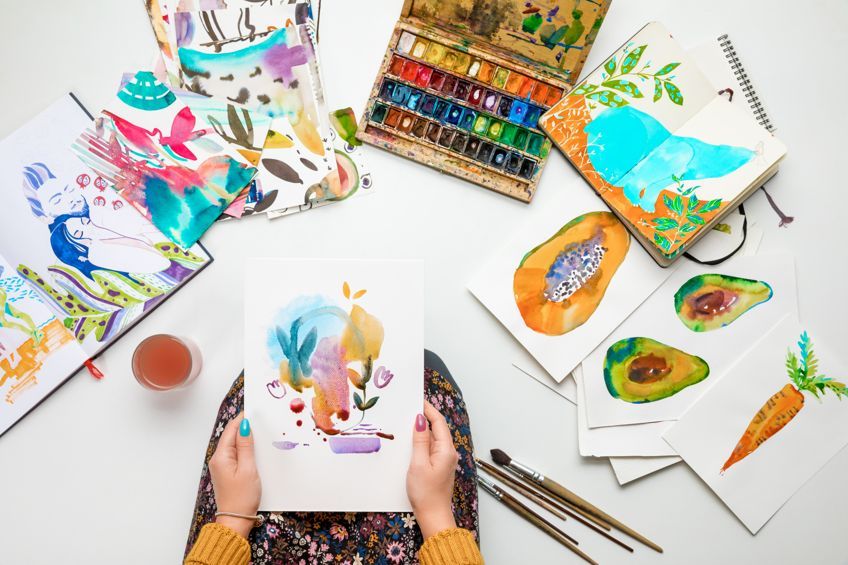
Now, artists have the power to share their work wherever and with whomever they want. It is almost expected that every artist must have some or other document that catalogs their available work. Let us look at what to put in an art portfolio for it to be a holistic and professional document (in this section we will only consider single document portfolios, like a PDF art portfolio. In the next section, we will look at what online portfolios make possible).
Deciding What to Put in an Art Portfolio
When you are creating an art portfolio you need to consider the main message you want to communicate. Once you have identified that, see how you can design your art portfolio to express that message as clearly and simply as possible. You need to consider whether you want to include all the different kinds of work you can do, or whether you want to have your art portfolio only show your most recent series of work.
If you are an artist that takes commissions, including your best past work to show potential clients all the kind of styles you can do, is a good idea.
If your portfolio will act as a kind of catalog for gallerists to view your current work, keeping it limited to the work you want to market and sell right now is the best way to go. You can have multiple sections in your art portfolio, but it is important not to overwhelm the viewer and to select only specific work to keep your portfolio concise.
Artist Bio
It is a good idea to start your art portfolio with an artist bio. An artist biography is a short account of the artist’s life and career. It gives a direct and short, paragraph structured description of what the artist has done up to the present moment in their artistic practice. Furthermore, it talks about the mediums, styles, subject matters, and collaborations they worked in as well as any other experiences applicable to their body of work. Include the main themes of your work in your artist bio, but keep the conceptual reasonings for your conceptual statement or exhibition text.
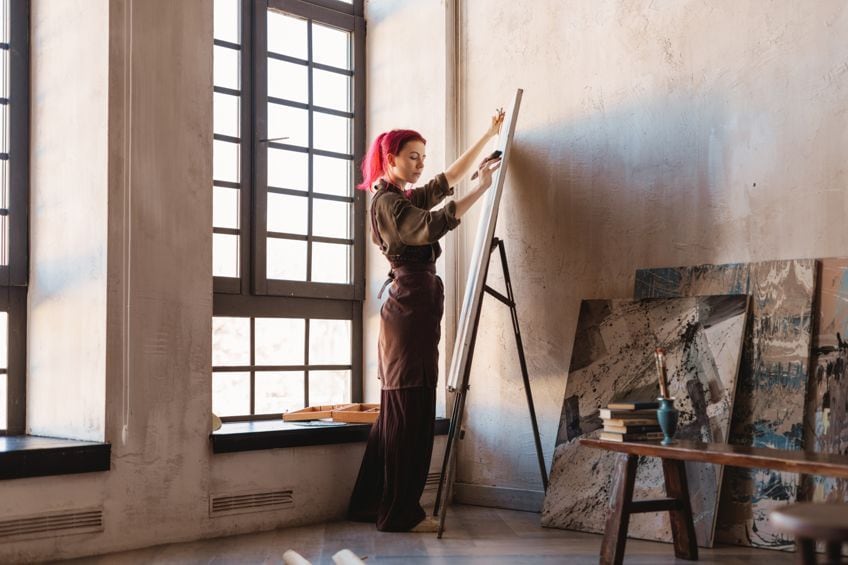
Including your artist bio in your art portfolio is a good idea as it will give the viewer an opportunity to connect more personally with you and your work. If you are showcasing your art on social media, have an artist website, or want to do independent exhibitions, it is also good to have a bio available so that interested viewers and collectors can read more about who you are as an artist and what kind of work you do.
Artist Portrait
If you choose to include an image of yourself in your art portfolio, remember it must be a professional image. It can be an image of you in your studio, painting, or making art but it should be high quality and relevant to your work as an artist.
Artist portraits also help the viewer to connect more to your work, but this is entirely optional.
Conceptual Reasoning
Depending on the artwork you choose to include in your art portfolio, it is a good idea to write a bit of text on the art you choose to display there. An artist statement or conceptual reasoning explains the symbols, methods, concepts, and subject matter of the work you create. It is a detailed rationale of why and how your work was created. This conceptual reasoning can be specific to a certain exhibition or series or be a general text about your art practice.

Consider including text in your art portfolio that will assist in the viewer’s experience, instead of distracting from it. This means, that the conceptual reasonings you include need to be relevant to the work on display in your art portfolio. Remember that the first focus of an art portfolio is the actual art pieces, so avoid making your portfolio too text-heavy.
Artwork Details
Besides the actual high-quality images of your art pieces, which is the core of an art portfolio, you also need to provide information about the artwork on display. Whether on your online art portfolio or your PDF document art portfolio, you need to include the artwork details. This is the size, medium, and name of the artwork.
You need to think carefully about displaying your prices openly on your portfolios or website. Most gallerists and collectors recommend not to include your prices in your portfolios as it might limit you.
Galleries often want to bump up the prices of young artists and if your audience already knows your price range, this could influence your artistic integrity. Instead, we recommend you include all the other details about the artwork and clearly state how you can be reached if someone wants to buy an artwork.
Contact or Purchase Details
We recommend including your contact details in the footer of every page of your art portfolio. It is also a good idea to state, consistently throughout your portfolio that viewers can inquire about artworks if they are interested. You can consider the following information format next to every artwork:
- Artwork name
- Artwork medium
- Artwork size
- Artwork series
- Inquire about the price via email
Creating an Online Art Portfolio
When you decide to work with a PDF document art portfolio, you will have to send it on to interested people, submit it for open calls, and share it with your audience through your newsletter. This, however, limits who you are exposed to. Having an online art portfolio opens up the possibility for anyone to discover you through the internet.

When you create an online art portfolio your options on what you can include and how expands. You can create multiple pages on your website that all act as extensions of your portfolio. You can have a section called “pasted exhibitions”, that shows work you have exhibited before. You can have a section on “commissions”, that lists past commissions to give clients an idea of what they can request. And you can have a “current catalog” page, that logs your most recent work.
As your website will have an “about” page, you do not have to include your artist bio in your portfolio pages as well. However, having snippets of your conceptual reasoning or the exhibition text of the specific series in your portfolio could make the viewing experience more engaging.
People often buy art for the stories they tell, so you can design a beautiful balance between text and images to invite the viewer into the ideas behind the art they are looking at.
You can consider hosting your online art portfolio on sites like Behance, Adobe Portfolio, or Weebly. There are multiple sites that allow you to build a simple portfolio with easy-to-use templates. You just need to look at as many of these hosting sites as possible to see what is a good fit for your needs. Here is a good example of an online art portfolio that includes dynamic web pages and PDF catalogs, hosted on Wix.
More Tips for Creating an Art Portfolio
Creating an art portfolio for your practice is as important (if not more) as creating an artist’s resume. You need to seriously consider what will make you stand out and whether your artistic vision and identity are communicated clearly.
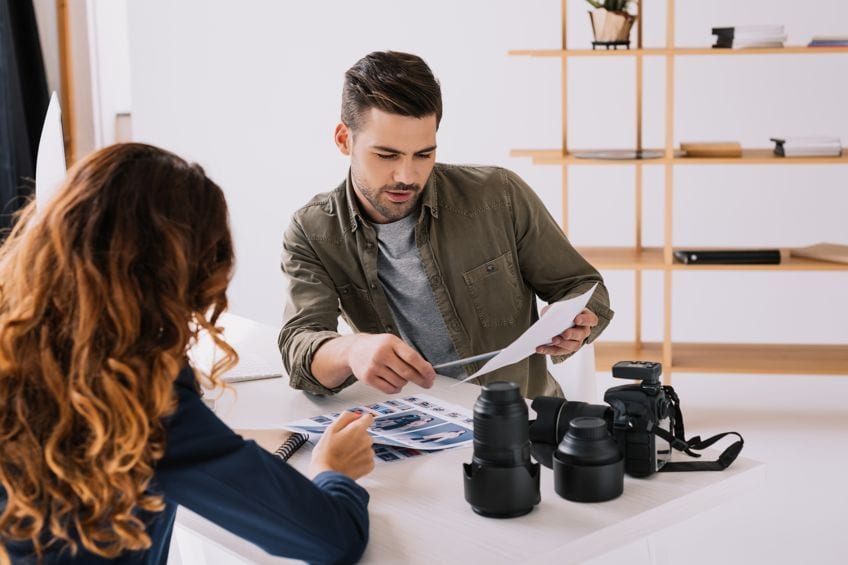
Consider What Will Make You Stand Out
Your art portfolio should be professional but should also grab the viewer’s interest. Including links that take readers directly to your website could make your portfolio more dynamic. You could include a page about your studio, with images of behind-the-scenes. This brings the viewer into your process and creates the sense that they are part of the making of the artwork. When viewers can see your process, they often feel invested in the final products.
This could be something you explore on your social media and then link your audience to your Instagram platform, for example, from your professional art portfolio.
It is always a good idea to give your audience as many resources to read about your work as possible. When a person discovers you for the first time and feels like they resonate with your work, they will often want to read more. If you choose to keep your art portfolio simple (which is a good idea), consider adding links to spin-off blogs, videos, or posts that could give someone already interested something extra about your practice.
Branding
Some artists might not think of their artist identity or their art practice as a brand, but the fact is that everything we want to sell today involves branding. You as an artist are a brand, your business and practice are also brands. Therefore, you need to consider how to create a consistent brand message through the content you share.
Creating a context for your work to be understood and engaged in will help frame your brand. Including your artistic values, history and the core message behind your art pieces are all key considerations in creating a definitive art style. All of this is communicated through your brand identity on your website, social media, or art portfolio.
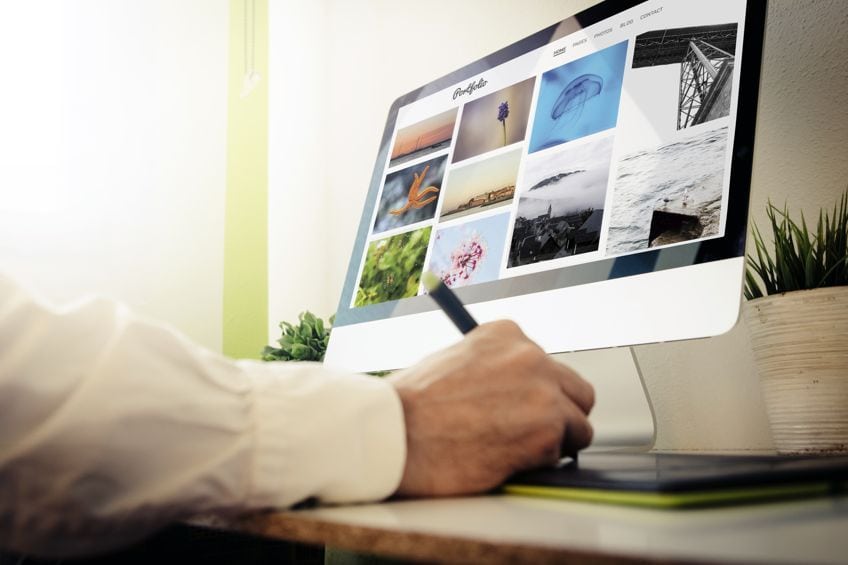
You do not have to depict your brand in a graphic way, but you can use subtle design elements to express your unique essence. Being consistent with color use, font types and page layouts can all help to strengthen your brand identity.
That being said, the main focus should remain on the art pieces. Do not include graphics, fonts, or colors that will distract from the actual art you want people to buy. All these design elements should highlight the work and contribute to the viewing experience.
Ask Others’ Opinions
When you are designing and compiling your support materials it is always a good idea to ask a friend, colleague, or another artist to read through your documents. Preferably choose someone that knows your work and will give you honest feedback on whether it accurately reflects what it is you do.

Creating an art portfolio is an exciting step in setting up your art business. It is an opportunity for you to think about how you want to world to view, engage and consume your art. It is a professional step that adds to the integrity of your business and artistic vision. If you do your research and spend quality time creating this portfolio it should reflect your artist identity, brand, and art style clearly.
Frequently Asked Questions
What Is an Art Portfolio?
An art portfolio is a document or webpage that records the work you do as an artist. Mostly, an art portfolio shows all the different kinds of art you have created throughout your career, almost like a visual resume. However, you can choose which art you would like to highlight in your portfolio.
What to Put in an Art Portfolio?
You should include details about you, the artist, like an artist’s bio and conceptual reasoning. Your art portfolio should have high-quality pictures of your art pieces, as well as details about the art pieces like the name, size, medium, and series it is part of. Remember to clearly state how people can reach you, purchase your artwork or inquire about your work.
When Should I Consider Creating an Art Portfolio?
If you want to be considered a professional artist you need to have some form of an art portfolio, whether that is a social media page, website, or PDF document. Art portfolios also come in handy when you want to submit your work for competitions, grants, or exhibitions.
Nicolene Burger is a South African multi-media artist, working primarily in oil paint and performance art. She received her BA (Visual Arts) from Stellenbosch University in 2017. In 2018, Burger showed in Masan, South Korea as part of the Rhizome Artist Residency. She was selected to take part in the 2019 ICA Live Art Workshop, receiving training from art experts all around the world. In 2019 Burger opened her first solo exhibition of paintings titled, Painted Mantras, at GUS Gallery and facilitated a group collaboration project titled, Take Flight, selected to be part of Infecting the City Live Art Festival. At the moment, Nicolene is completing a practice-based master’s degree in Theatre and Performance at the University of Cape Town.
In 2020, Nicolene created a series of ZOOM performances with Lumkile Mzayiya called, Evoked?. These performances led her to create exclusive performances from her home in 2021 to accommodate the mid-pandemic audience. She also started focusing more on the sustainability of creative practices in the last 3 years and now offers creative coaching sessions to artists of all kinds. By sharing what she has learned from a 10-year practice, Burger hopes to relay more directly the sense of vulnerability with which she makes art and the core belief to her practice: Art is an immensely important and powerful bridge of communication that can offer understanding, healing and connection.
Nicolene writes our blog posts on art history with an emphasis on renowned artists and contemporary art. She also writes in the field of art industry. Her extensive artistic background and her studies in Fine and Studio Arts contribute to her expertise in the field.
Learn more about Nicolene Burger and the Art in Context Team.
Cite this Article
Nicolene, Burger, “How to Make an Art Portfolio – What Is an Art Portfolio Used For?.” Art in Context. November 21, 2022. URL: https://artincontext.org/how-to-make-an-art-portfolio/
Burger, N. (2022, 21 November). How to Make an Art Portfolio – What Is an Art Portfolio Used For?. Art in Context. https://artincontext.org/how-to-make-an-art-portfolio/
Burger, Nicolene. “How to Make an Art Portfolio – What Is an Art Portfolio Used For?.” Art in Context, November 21, 2022. https://artincontext.org/how-to-make-an-art-portfolio/.


